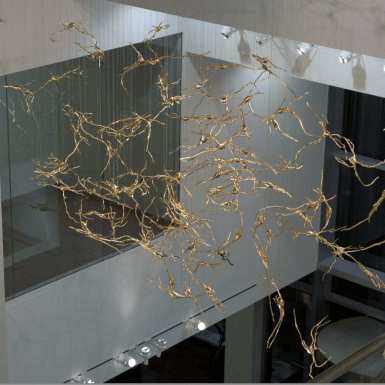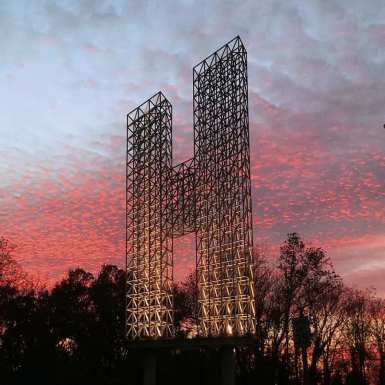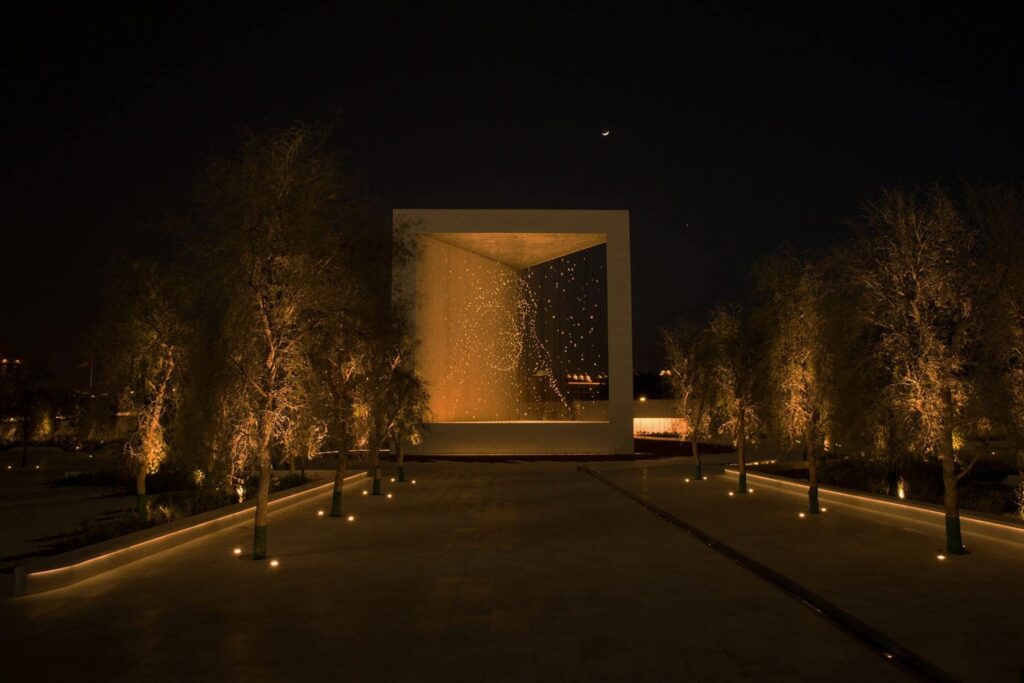
About the Art
Floating World is inspired by the paintings of Grant Wood and by compositional strategies of Japanese woodblock prints (ukiyo-e, literally “floating world”). Commissioned by the University Museums – Art on Campus Program at Iowa State University (ISU) in 2014, the sculpture embodies ISU’s central role in the history of agriculture while reflecting its groundbreaking contemporary endeavors.
Floating World is installed in the atrium of one of the world’s foremost centers for agricultural research, The ISU Biorenewables Complex.
The three-story suspended sculpture includes eight laser-cut steel panels that depict changing horizons illustrating the evolution of agriculture from the 19th century to the modern day. These historic panels are interspersed with abstract optically porous perforated “mist” layers to evoke an Iowan landscape at sunrise. The entire composition is backed by an epic map showing the rivers of Iowa.
Viewed from one end of the atrium the massive and complex sculpture aligns into an orderly illustration of the history of agriculture. When viewed from the opposite end of the atrium the sculpture offers a chaotic unpredictable display of shifting light and shadow that embodies the essentially elusive nature of history.
Six 3-foot-diameter sun circles progress diagonally over the landscape panels. They represent the sun, the ultimate source of agricultural energy. They include images relating to work being pioneering on a molecular level within the Biorenewables Complex (see the blowup detail in the image below).

Beneath the suspended sculpture seven circular terrazzo medallions create “you are here” story of scale, starting with a planetary array, zeroing down to a plan view of the atrium and continuing to a carbon molecule. The terrazzo medallion about the paths of the planets is included in the physical book.
About the Artist
Ralph Helmick (b.1952) is an accomplished sculptor who explores the intersection of art and science. He obtained a BA in American Studies from the University of Michigan, attended the Skowhegan School of Painting and Sculpture in Maine, and received an MFA in Sculpture from the School of the Museum of Fine Arts, Boston at Tufts University, Medford, MA.
Helmick manipulates distance, perception, and other visual phenomena in Floating World and his other sculptures. As a child and student Helmick was very influenced by the science and design of the Foucault pendulum and Muybridge’s sequential photos.
After completing Floating World, Helmick installed many additional prominent sculptures during 2016 – 2018. Images of five are included below: Schwerpunkt; Return; n + 1; The Constellation; Edifice.


Schwerpunkt, 2016, the McGovern Institute for Brain Research at MIT, Cambridge, Massachusetts

Return, 2018, Hopewell, Virginia

n + 1, 2018, Tampa International Airport, Florida



The Constellation, 2018, The Founder’s Memorial Park, Abu Dhabi, United Arab Emirates

Additional image of The Constellation provided by Dr. Klemm on her trip to Abu Dhabi in March 2022.

Edifice, 2018, The Notre Dame Stadium in Notre Dame, Indiana
Relevant Terminology/History
A molecule is a group of atoms bonded together, representing the smallest fundamental unit of a chemical compound that can take part in a chemical reaction.
Biorenewables are carbon-based molecules that are the primary basis of the fuels, chemicals and materials required by society. They are able to be renewed via biological organisms. Biorenewables research at ISU is developing analogous technologies that use biomass-derived carbon.
Foucault pendulum is named after the French physicist Léon Foucault. Hanging from a ceiling, it was created to demonstrate the Earth’s rotation.

Foucault’s pendulum, Panthéon, Paris, image courtesy of Wikipedia
Muybridge’s sequential photos—Horse in Motion– is a series of cabinet cards that each show a sequential series of six to twelve “automatic electro-photographs” depicting the movement of a horse.

Horse in Motion, photographs, June 1878
Organic chemistry isthe scientific study of the structure, properties, and reactions of organic compounds and organic materials, i.e., matter in its various forms that contain carbon atoms.

The hexagonal molecule of benzene is composed of six carbon and six hydrogen atoms (see above). Known as the “turtle shell” it is one of the most beautiful structures in organic chemistry and regarded as a symbol of the field.
Platonic solids are polyhedrons, all of whose faces are congruent regular polygons, and where the same number of faces meet at every vertex. The six spheres each corresponded to one of the planets (Mercury, Venus, Earth, Mars, Jupiter, and Saturn). The solids were ordered with the innermost being the octahedron, followed by the icosahedron, dodecahedron, tetrahedron, and finally the cube.

Graphic courtesy of Wikipedia
*Fun Fact: The sculpture, The Constellation, consists of 1,327 platonic solids suspended on 1,110 cables. They are known for their mathematical beauty and symmetry. The clever use of the moving platonic solid create a 3-D portrait of Sheikh Zayed’s (founder of United Arab Emirates). As the solids move, they timelessly evoke his enduring vision, which continues to inspire the people of the UAE and beyond.
Learning Guide

- What do you think the title has to do with the art?
- Why do you think Number Character 8 is speaking about the terrazzo floor diagram of the planets’ paths?
- How does the red image with white numbers relate to Floating World? Can you find it in the sculpture?
- How does the blue hidden image relate to Floating World?
- Helmick was interested in Muybridge’s sequential photos as a child. Have you seen them before? Do you notice any influence of the sequential photos in Floating World? Any of the other sculptures shown above? Discuss your ideas with your friends and family.
- Helmick was also influenced by the Foucault pendulum as a child. Have you seen on before? If so, where? Do you notice any influence of the Foucault pendulum in Floating World? Any of the other sculptures shown above? Discuss your ideas with your friends and family.
- How do you think this might have influenced Helmick to include six sun circles in Floating World? Discuss your ideas with your friends and family.
- Can you think of any numeric link to seven that Helmick used for the number of terrazzo diagrams in Floating World? Discuss your ideas with your friends and family.
- Look at the image of the platonic solids. Many of the names end with “hedron” and begin with the Greek word for the number of sides. Which one(s) does not follow the pattern? How would you rename it/them to follow the pattern of the others?
